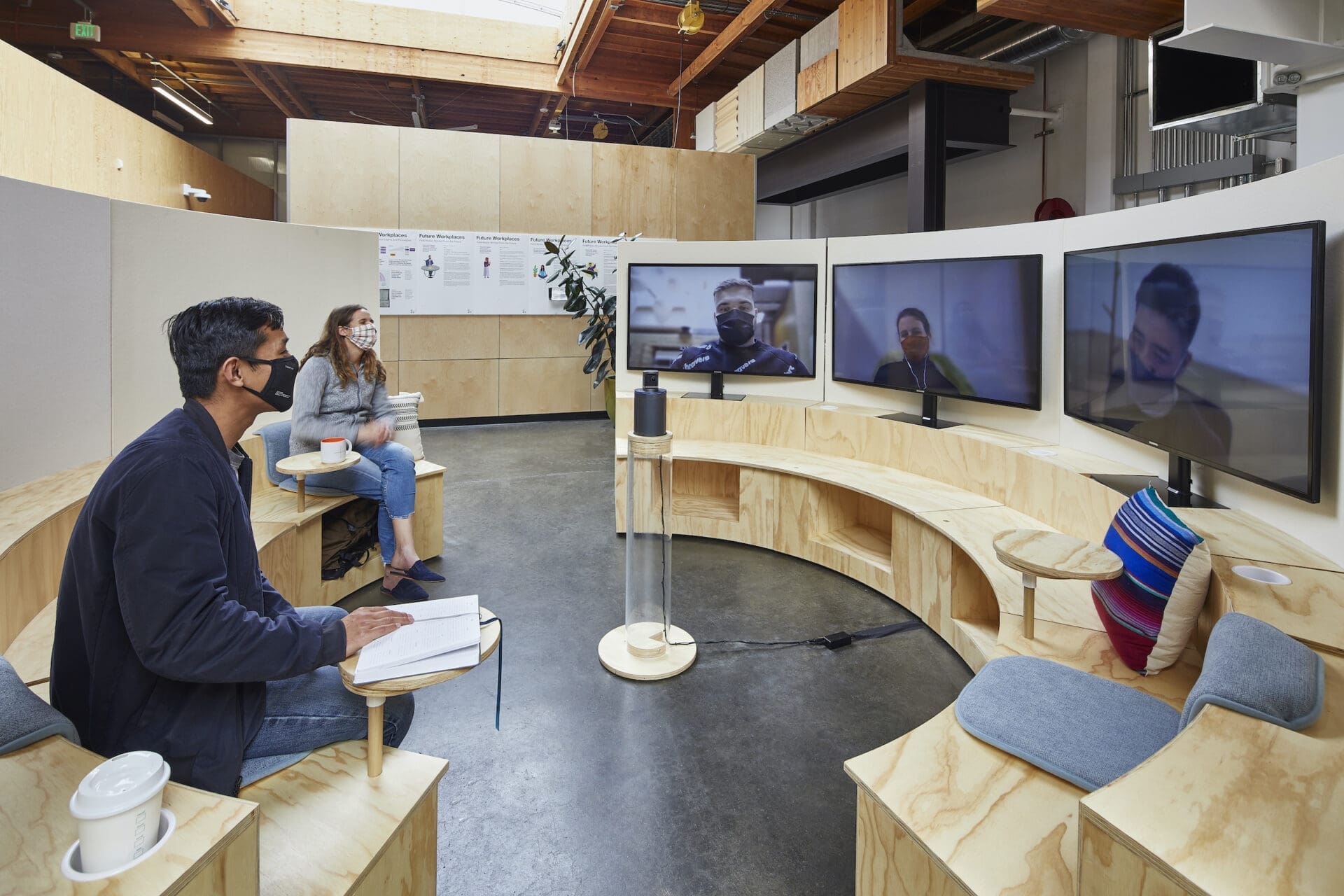Which companies are going hybrid?
Remote-only, hybrid working model, or all staff back in the office? As vaccinations roll out and economies tentatively open up, organizations are working out what their new normal will look like. For some, the pandemic accelerated a transition to flexible working that had been brewing for some time. Others are keen to get back to a traditional office setup – as far as possible.
But going hybrid is more than just functional – the when and the what. It’s about company culture. How much freedom employees are afforded, how prescriptive the leadership style is, and how prized innovation is will all influence where a company falls on the hybrid spectrum.
How 10 companies are approaching hybrid working – or not!
From Netflix to Google, let’s take a look at how different companies are approaching going hybrid. Some have focused on teamwork and collaboration, others on flexibility or wellbeing. And for the traditionalists, it’s all about getting back to the office and seeing their coworkers again.

Source: CoScreen
Remote-first approach
For many businesses, the pandemic highlighted how effective a remote-first setup can be. Fully remote companies are now eschewing the traditional office setup to give employees the flexibility and freedom to work from home, while remote-first companies let them choose where they work. This means employees aren’t expected to work for the company office.
1. Coinbase ‘No-office Headquarters’
Crypto currency exchange Coinbase has closed its main office headquarters for good and will encourage employees to work remotely or at smaller, local offices. Company founder and former Airbnb engineer Brian Armstrong sees it as a democratizing move that ensures equal career opportunities for all employees, no matter where they are based.
An official statement said: “Closing our SF office is an important step in ensuring no office becomes an unofficial HQ and will mean career outcomes are based on capability and output rather than location. Instead, we will offer a network of smaller offices for our employees to work from if they choose to.”
2. InVision: International Reach And Employee Happiness
Did you know that InVision has a director of Employee Happiness? Making their employees happy is an important objective for InVision. To that effect, the company has a house swaps channel that keeps employees aligned and connected.
As far as fully remote companies go, InVision has mastered the art of providing a company culture that hires a top talent team of hard-working and humble individuals. This is in addition to excellent company values and an amazing product that customers love because it is aligned to their needs.
More than that, InVision is globally distributed with an international reach. As one of the company’s benefits, employees can swap locations to work and travel to new places across the globe. This comes with excellent medical insurance, a free gym membership package, and options packages that imbue the feeling of company ownership.
3. Equinix: Drop-in workspaces
Multi-national Equinix has a remote-first model centred on flexibility. There’s no location requirement for staff, though drop-in co-working spaces are available in certain locations. A long-term IT strategy based on flexible digital infrastructure meant that the company already had in place the technology to enable remote working when the pandemic hit. They’re also looking at enhancing their in-office experience, including hybrid meetings where your Zoom call launches automatically as you walk into your pre-booked meeting room.
4. Buffer: Solves Remote Loneliness
In 2020, Buffer discovered that twenty percent of remote workers struggle with loneliness. Therefore, the company put measures to help their fully remote employees work through unplugging and loneliness feelings. This was achieved by offering a monthly stipend to every remote employee for coffee shops. When employees work in a coffee shop, the different energy and setting mitigate loneliness.
5. Go Daddy: Empower Employees Outside Work
Imagine working for an organization that lets you take a part-time job outside your office hours. More than that, the company helps you pursue the side hustle. This is what Go Daddy does. The company has a culture of empowering its remote workers beyond their responsibilities at work.
This means that any employee with a hobby they would love to monetize will get help from Go Daddy. In addition, the company offers opportunities for workers to enhance their careers through education.
Go Daddy has a flexible work schedule to ensure workers are not overwhelmed, meaning you can schedule your working hours around taking care of pets and children. Go Daddy expresses the advantages of working for fully remote companies that value their employees.
6. Airbnb: Let employees take charge
“Employees are in charge, not companies”, says Airbnb CEO and Co-Founder Brian Cesky.
With an agile and decentralized business model, Airbnb has fully embraced flexible working, allowing employees to work from wherever they choose. Their logic? Employees want it, so Airbnb needs to accommodate it to attract the best people, as Cesky says: “The employees and the talent market is going to drive working flexibility, not the companies. Because if a company says these are our rules, they’re not going to have the talent.”
7. Doist: Asynchronous Working Hours
Doist has worked hard to fully accommodate its employees and provide an entirely flexible experience. The company is one of the global, remote-first, and fully remote companies that care significantly about employees. For example, new parents can bring their baby and partner to the company retreat. You also choose your coworking office based on your preference, and the working hours at Doist are entirely flexible as long as you clock 40 hours at the end of each week. Doist primarily works as a remote-first company.
8. Close: Focus On Deliverables
This fully remote company helps businesses convert traffic into revenue into leads. Close doesn’t focus much on working hours. Instead, the company looks at the deliverables of each remote employee every week. Close offers its employees realistic projects, deliverables, and deadlines and empowers them to work on the deliverables individually. In addition to this flexibility, Close offers a monthly $200 coworking stipend and two annual team retreats.
Going hybrid with a focus on teamwork
Companies like Google, Facebook and Fujitsu have put in place infrastructure that helps bring their respective teams together to reignite collaboration and connection.
9. Google Campfires

Google has long been a workplace innovator. The Googleplex’s open plan offices with bright and bold common spaces and free food and transport seemed like a window into the future when it launched back in 2003.
In 2018 Google commissioned a team of space architects, engineers, builders and tech specialists to redesign the workplace environment around three principles: work can happen anywhere, workplaces are more than desks and meeting rooms, and employees’ needs are changing constantly.
Its post-pandemic innovations focus on facilitating hybrid working, and include flexible team pods that can be reconfigured quickly to meet different needs, and “campfires” that cater for hybrid meetings. A campfire features a seating circle interspersed with vertical digital displays that show remote attendees dialing in, to try to establish an equal footing for all participants.
10. Fujitsu Creative Hubs
Pre-pandemic, the Fujitsu culture prized long hours in the office and face-to-face work. But fast forward 18 months, and 85% of employees favor either a remote or hybrid workplace model. To support the transition, the company has committed to creating an ecosystem of workspaces designed to cater for different needs. The setup is made up of hubs, satellites, and shared offices.
Hubs will facilitate creativity, co-creation and serendipitous encounters between colleagues. Satellites will enable teams to coordinate shared projects using video conferencing and face-to-face meetings, and shared offices provide easily accessible spaces in urban centres for employees who want to use an office for independent work, online meetings or virtual training.
11. Facebook: A place for culture building
In another vote for a hybrid, remote-first model, Facebook plans for many of its employees to work off-site most of the time – but come into the office for culture building, training, key meetings and events.
The social media giant is actively hiring remotely too, particularly for senior level staff who don’t need as much in-person training or career development support. CEO Mark Zuckerberg sees it as a boon for diversity, as he can recruit outside of traditional tech communities such as Silicon Valley and San Francisco: “Enabling remote work is going to be very positive on that front toward creating more broad-based economic prosperity.”
A focus on employee wellbeing
From recognizing meeting fatigue to a clearly-communicated phased return, Microsoft, Coda and Intel have prioritized employee wellbeing.
7. Intel: Meeting-free Fridays
Intel is embracing hybrid working, and is making cultural changes to help ease the burden on remote workers. To combat meeting fatigue – something most of us will be familiar with – they’re instigating meeting-free Fridays. They’ve also set meeting start-times at ten past the hour to make them shorter, and are encouraging days off to disconnect.
8. Microsoft: Phased return to the Office

Microsoft has in place a phased return to the office that includes different stages, ranging from remote-only to fully open campuses. Even with fully open campuses, hybrid work and flexibility will be the order of the day. Microsoft describes their research-driven approach to designing agile workspaces that encourage collaboration and meet the diverse needs of its teams.
9. Coda Inclusive Meetings
Online collaboration firm Coda has embraced the refreshed company culture forced upon them by mandatory remote work. They’ve made their meeting cadence lighter and more inclusive to cater for employees spread across different locations. Meetings are now all held at 1 pm and recurring meetings are banned on Wednesdays to allow time for focused work or for employees to change work locations and balance other life commitments. They’ve also introduced a company-wide social hour to help with isolation, including quizzes, cocktail-making and online games.
Office-first model
To keep the balance, here’s one example of a business that’s bucking the flexibility trend and keen to get back to how things were.
10. Traditionalist Netflix
Netflix is going against the grain and has come out as staunchly office-first. The world’s largest subscription streaming service expects employees back in the office this fall. However, CEO Reed Hastings does acknowledge the hybrid workplace is here to stay, accepting that most companies will end up seeing employees work “four days in the office while one day is virtual from home.”
A final thought on how organizations are adapting to the new era of work
Organizations are working out where they sit on the workplace spectrum, from 100% remote to a traditional office. The in-between – a hybrid model – is favored by the majority. Hybrid ranges from office-first (remote is available but in-office work is preferred) to default digital (no location requirement but co-working spaces are available in certain locations).
Offices are changing to accommodate hybrid working models, reflecting the need to support collaboration, facilitate serendipitous encounters and provide quiet workspace for employees who need or prefer to work from an office. Company culture is in transition too. Remote workers are at risk of becoming isolated, burnt out or feeling left out. Care needs to be taken to mitigate against these challenges to ensure a happy and productive workforce.
Any hybrid working model will require innovative digital infrastructure to support it too. Desk scheduling software, such as Kadence, is one such tool. It allows employees to reserve office space when they need it, making their in-office experience as seamless as possible, and gives organizations data on how space is used so they can optimize their workplace based on historic and forecast usage.





